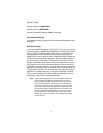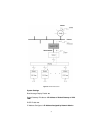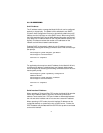35
User Authentication Protocol: pap
EIA232 Raw-TCP/Telnet Settings
Connection From Local Enable: no
Connection From Remote Enable: yes
Connection Retry Frequency (sec): 0
Local Port: 404 (or required setting)
Remote IP Address: 1.1.1.8
Remote Port: 23
Remote Password: (UNDEFINED)
Remote User ID: (UNDEFINED)
Session Termination Character: 0x04 (or preferred)
User Database Settings
Should include user names, passwords, and privileges of all users and
administrators
SLIP Operation
In the typical SLIP application (see Figure 9), the user has a need to
remotely connect to a LAN for general access to the LAN (e-mail, appli-
cations, etc.) or for access to the Internet. To make this connection, the
user typically uses a dial-up modem with standard POTS line and
launches a SLIP application to connect with a dial-up (or ISDN) modem
connected to the LAN. Once the connection is made between the SLIP
and the modem, the Model 2120 will establish a connection with the LAN
using a static IP address assigned by the Network Administrator. Once
connected to the LAN, the user is permitted access to the LAN for gen-
eral or Internet access (SLIP will require user name put in 2120 data-
base if there is one). The data from the SLIP client application and LAN
is converted into SLIP packets and the data is moved back and forth
through the established SLIP connection and over the LAN. For domain
name resolution, the Model 2120 must obtain name server addresses
from the SLIP client device connected to the serial interface. In this type


















